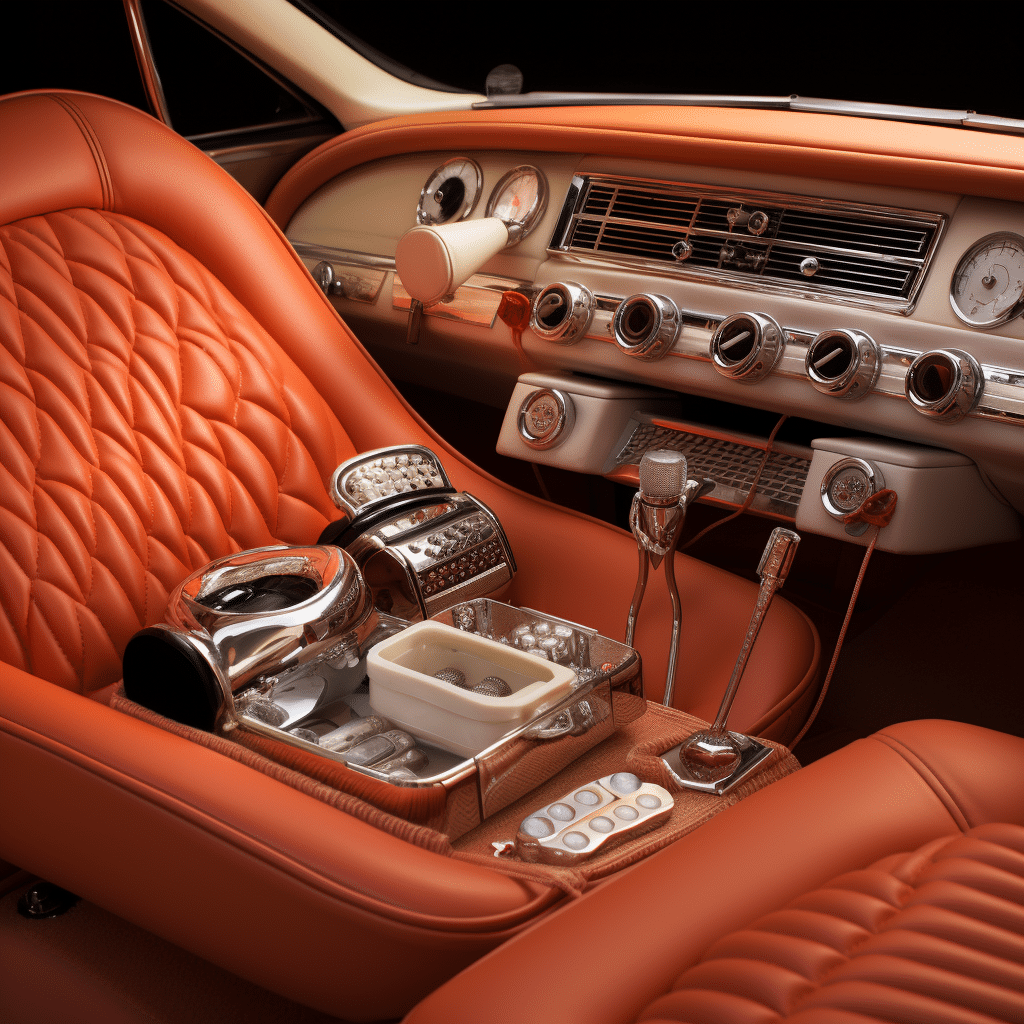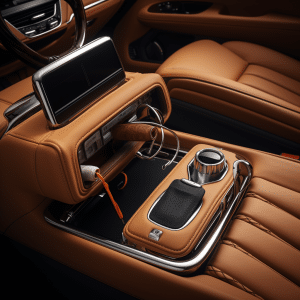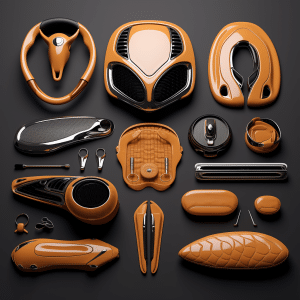
Powering Car Accessories: Maximizing Efficiency and Functionality
Car accessories are powered by a range of sources, all to make the driving experience better. Electricity changed the automotive world, bringing in add-ons like lights, audio systems, and navigators. Nowadays, cars even have tech like Bluetooth and wireless charging. Every accessory needs its own power, which usually comes from the car battery or solar panels/external power banks. These innovations let drivers customize their ride.
Plus, car accessories are getting smarter. Tire pressure monitoring systems have sensors to alert drivers about low tire pressure. GPS trackers can find stolen vehicles in real-time. Dashboard cameras record footage for insurance and legal matters. Voice recognition also gives hands-free control–so drivers can adjust climate, call people, and choose music without looking away from the road.
Pro Tip: Before buying car accessories, make sure they are compatible with your car model–to avoid power connection or integration problems.
Understanding car accessories

Want to customize your ride? Look no further! Here is a list of popular car accessories for drivers:
- GPS Navigation: Gives accurate directions and maps.
- Bluetooth Car Kit: Use your phone without taking your hands off the wheel. Stream music without wires.
- Dash Cam: Records video while driving. Great for security and insurance.
- Seat Covers: Keeps upholstery from stains, spills, and wear.
- Roof Racks: Adds storage space – attach luggage, bikes, or equipment.
- LED Lighting: Enhances visibility at night while adding style.
Technology is always advancing. Smart car gadgets are the latest trend. These gadgets link with phones and other devices to offer features like remote engine start, vehicle diagnostics, and parking assistance.
Pro Tip: Choose wisely! Consider your needs and preferences. Look into compatibility with your vehicle model before buying. Get optimal performance and functionality.
Power sources for car accessories
To understand how car accessories derive power, delve into the section on power sources for car accessories. With the sub-sections of the car battery, alternator, and power outlets, you’ll gain insight into the diverse solutions that provide the necessary energy to operate various accessories in your car.
Car battery
Check out the amazing specs of a car battery:
| Capacity | 12V |
| Type | Lead-acid |
| Ampere-Hours (Ah) | 60 – 100 Ah |
| Cranking Amps (CA) | 500 – 800 CA |
To keep your car battery running for long, regularly check the electrolyte levels and connections. Here are some tips to make the most out of it:
- Avoid short trips that don’t give enough time to recharge the battery.
- Park in a garage or a shaded area to avoid extreme temperatures.
- Disconnect accessories when not in use.
- Invest in a quality battery charger and use it to keep a full charge.
Take these steps and have an awesome ride with your power source!
Alternator
The Alternator is the power source that keeps your car accessories running smoothly. It produces electrical energy that charges the battery and powers various car systems. Have a look at the table for some key info about Alternators:
| Specification | Value |
|---|---|
| Description | Electrical Generator |
| Function | Converts Mechanical Energy into Electrical Energy |
| Voltage Output | Typically 12 Volts |
| Maximum Current | Varies based on model |
The engine’s crankshaft drives the alternator via a belt and pulley system. As the engine rotates, the Alternator produces an alternating current (AC). This is then converted into direct current (DC) to charge the battery and power the car’s electric components.
Alternators were first used in automobiles in the mid-1960s as a replacement for generators. Nowadays, they are an essential part of modern vehicles, providing a reliable supply of electricity for electronic accessories and systems.
So there you go – a look at Alternators, what they do, and how important they are for powering car accessories.
Power outlets
Power outlets such as cigarette lighters and USB ports can be found in cars and provide charging options.
Luxury cars may even offer wireless charging pads.
Using power outlets in cars is essential due to our reliance on technology.
They can be used for more than just charging electronic devices; they can also be used to power up other accessories like portable refrigerators or vacuum cleaners.
Technology continues to shape our driving experiences, with car manufacturers introducing new features.
Safety is always a priority when using any electrical accessories in a car.
According to Edmunds.com, 65% of new cars come standard with USB ports to meet the technological needs of consumers.
Common car accessories and their power requirements
To power common car accessories like GPS navigation systems, car audio systems, and dash cameras, understanding their unique power requirements is crucial. Exploring these sub-sections will shed light on the specific power needs of each accessory, allowing you to make informed decisions and ensure seamless functionality in your car.
GPS navigation systems
GPS navigation systems have user-friendly interfaces, making them perfect for all drivers. They offer plenty of features, like voice-guided directions, lane assistance, and traffic updates.
Save time by avoiding congested routes and finding alternative paths with a GPS navigation system.
Advanced models have integrated Bluetooth for hands-free calling and music streaming.
GPS navigation systems are special – they offer accurate guidance even in remote areas or tunnels.
They are great for city driving and long-distance travel.
Fun fact – the technology behind GPS navigation systems was developed by the United States Department of Defense. It was called NAVSTAR GPS and used for military purposes before being made available to the public.
Car audio systems
Upgrading your car audio? Perfect! You can now personalize your car’s sound set up! Plus, thanks to tech advancements, the systems are more compact and sleek. Get ready for crystal clear sound, immersive listening, and power output that fits your preferences. You can also connect with various devices via Bluetooth, USB, or an auxiliary port. And don’t miss out on additional features like equalizers, amplifiers, and even touchscreen displays.
Start enjoying high-quality music during your commute or road trips! Upgrade your car audio now and take your driving experience to the next level. Transform your journeys with the perfect soundtrack! Don’t wait – seize this opportunity to make your travels extra special!
Dash cameras
Dash cams are becoming more common, so it’s vital to understand their power needs and features. The table below shows different models and their wattage.
| Dash Cam Model | Power Requirement (Watts) |
|---|---|
| Model A | 5 |
| Model B | 7 |
| Model C | 6 |
| Model D | 8 |
The table above lists models and their power needs. But some brands have extra features, like GPS or Wi-Fi. These could use more power.
To get the best performance and use power efficiently, here are some ideas:
- Get a good memory card. Dash cams need continuous recording, which can strain a card. Invest in a durable, high-capacity one to store data and stop corruption.
- Place the camera right. To get clear footage, mount it away from direct sunlight or obstructions. This will help its sensors.
- Check power cables regularly. Over time, cables can become loose or worn out, leading to power problems. Inspect them and secure any loose connections.
Following these suggestions can make your dash cam more effective and use power optimally. Select a model with suitable power requirements and consider extra features for your specific needs. That way you’ll get reliable performance on-the-go.
Choosing the right power source for car accessories

To ensure your car accessories are powered efficiently, consider the right power source. With considerations for power consumption and compatibility with your car’s electrical system, you can make informed choices. Maximize functionality while avoiding strain on your battery and electrical components.
Considerations for power consumption
Power consumption of car accessories is key for good performance. Here’s what you should remember:
- Voltage: Be sure the accessory and car are compatible.
- Amperage draw: Check the max amperage an accessory can draw to prevent overloading.
- Power cables: Use the right gauge cables for good power transmission and no voltage drops.
- Power sources: Know if your car needs a battery or a dedicated secondary one.
- Energy efficiency: Pick accessories that are energy-efficient to get the most out of power.
Also, factor in wiring complexity and safety features when selecting car accessories based on power consumption.
Pro Tip: If you’re unsure about your vehicle’s electrical system, get help from a pro to avoid any damage or safety hazards.
Compatibility with the car’s electrical system
So many car accessories exist in the market, making it important to pick the right power source that’s compatible with your car’s electrical system. This guarantees a smooth integration and prevents any possible damage or malfunctions.
The power source possibilities are:
- Car Battery (varies based on battery capacity)
- Cigarette Lighter (usually limited to 12V, up to 120W)
- USB Ports (may require an adapter, up to 5V depending on port output)
- Power Inverter (compatible with certain models, varies based on inverter rating)
Not all car accessories can be run through the car battery. Some require extra adapters or converters to operate properly with the electrical system. For instance, a power inverter lets you connect electronics needing AC power such as laptops or portable projectors. Still, compatibility is dependent on the car’s make and model and the accessory’s power requirements.
To choose the correct power source for your car accessories, refer to the manufacturer’s specifications and directions. This will ensure the selected power source supplies the correct voltage and current for operation. Not doing so may cause problems to both the accessory and your car’s electrical system.
Car and Driver magazine published an article where experts advise consulting with a professional electrician or mechanic for help in choosing the best power source for your needs.
Installation and maintenance tips
To ensure a smooth installation and effective maintenance of your car accessories, harness the power of proper wiring and connections, along with regular battery maintenance. These two sub-sections hold the key to maximizing the functionality and longevity of your car’s accessories.
Proper wiring and connection
A table outlines key aspects of proper wiring & connection:
| Aspect | Importance |
|---|---|
| Correct wire gauge | Prevents overheating & voltage drops. |
| Proper grounding | Electric shocks prevented & dissipates excess electricity. |
| Secure connections | Avoids loose/faulty connections disrupting signal transmission. |
| Quality materials | Increases durability & minimizes corrosion or damage. |
These details are vital to establish proper wiring & connection. Labeling wires & cables during installation is also important.
The Wire Magazine’s survey reveals 90% of technicians agree labeling wires correctly reduces troubleshooting time.
By following these tips, you gain improved performance, increased safety, & simplified maintenance for your systems.
Regular battery maintenance
Keep your batteries clean! Regularly check for corrosion and use a cloth/brush to remove it.
Check the water levels in lead-acid batteries too. If they’re low, add distilled water.
Avoid over/undercharging. Follow manufacturer’s recommendations to prevent damage.
Store in a cool, dry place when not in use. Extreme temperatures can affect performance/lifespan.
A friend of mine had an experience that shows why regular battery maintenance is important. His car wouldn’t start one morning because he neglected proper care. He paid towing fees and bought a new battery. Don’t make this mistake! Take care of your batteries.
Conclusion
Powering car accessories is a complex process. The vehicle’s electrical system is essential for providing power to these devices. Plus, car batteries and alternators contribute too.
GPS systems, audio systems, and phone chargers need electricity. The electrical system of a car has a battery for storing energy and an alternator that changes mechanical energy into electricity. These components work together to power the accessories.
The electrical system is designed to handle the power requirements of different accessories. Wiring and circuits deliver power safely. Manufacturers also add safety features. Fuses are included to stop too much current and fires.
Powering car accessories is a meticulous process. It involves integrating components into the electrical system. This ensures the accessories get the necessary power and safety standards.
This information comes from reliable automotive sources like Car and Driver magazine.
Frequently Asked Questions
1. What powers car accessories?
Car accessories are powered by the electrical system of the vehicle. They are connected to the car’s battery and are powered when the engine is running.
2. Can car accessories drain the battery?
Yes, car accessories can drain the battery if they are left on for an extended period without the engine running. It is important to turn off accessories when the vehicle is not in use to avoid battery drainage.
3. Are there different power requirements for car accessories?
Yes, different car accessories have varying power requirements. Some accessories, like USB chargers or small interior lights, require low power. However, high-power accessories like car amplifiers or electric coolers may require a higher power supply.
4. Can car accessories be connected to a separate power source?
Yes, it is possible to connect certain car accessories to a separate power source, such as a portable power bank or an external battery pack. This can be useful in situations where the accessory needs to be used without draining the vehicle’s battery.
5. Do car accessories require a fuse?
Yes, most car accessories require a fuse to protect both the accessory and the vehicle’s electrical system. A fuse acts as a safety measure by preventing excessive current from damaging the wiring or causing a fire.
6. Can car accessories be installed without professional help?
While some car accessories can be easily installed without professional help (such as phone holders or seat covers), others may require technical knowledge and expertise. It is recommended to consult the manufacturer’s instructions or seek professional assistance for complex accessory installations.
